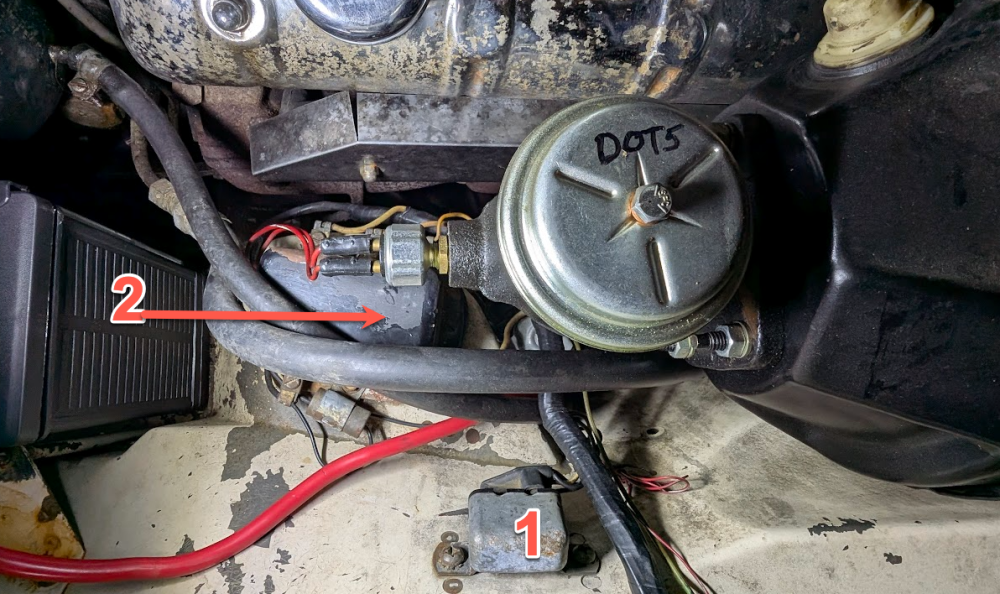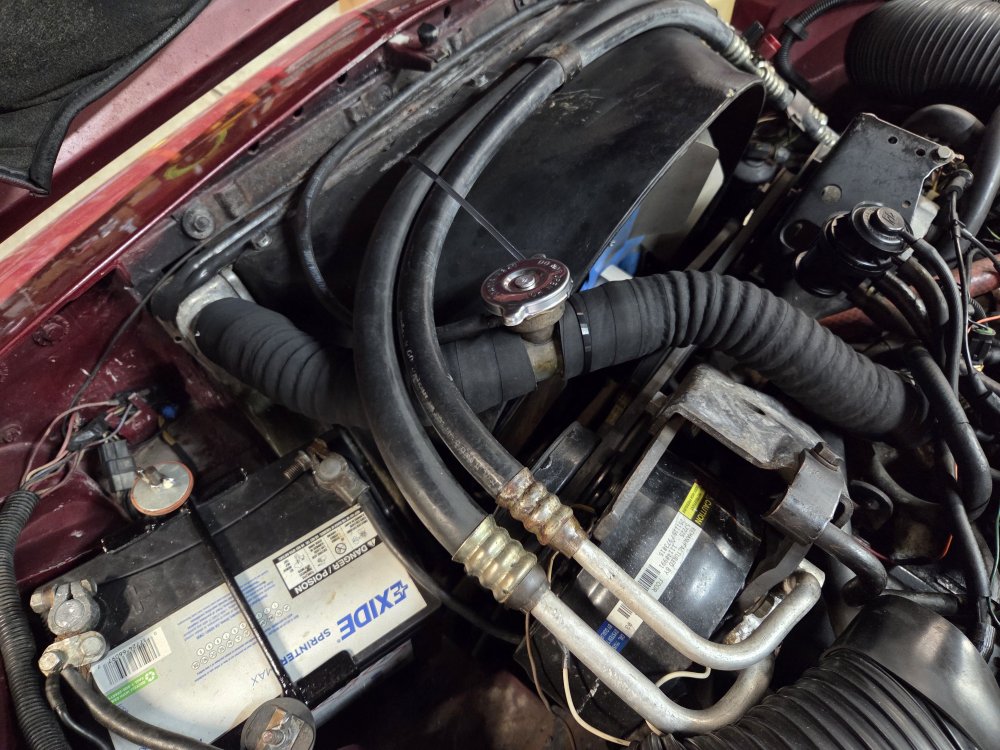
mfg
-
Posts
13,396 -
Joined
-
Last visited
Content Type
Profiles
Forums
Events
Posts posted by mfg
-
-
The two upper curved carpets look like the console forward side pieces.
-
Jim made Studebaker Avantis ‘ jump through hoops’ at Bonneville… He will be truly missed.
-
Whew!…. My simple on-off toggle switch, which controls converter lockup, was installed approx 15 years ago in my 700R4…. Have had no transmission problems whatsoever with an ‘83 Avanti used everyday—- summer and winter!
Cost at the time… about $4.00
-
5 hours ago, Kane said:
I need some ideas here. On my 82 the trunk slammed shut and now, the power trunk release does nothing. Makes no noise…nothing. Anybody know how to get the trunk unlocked/unlatched so I can get inside it and figure out what happened?
TIAYou can release trunk lock by opening hatch under rear window… reaching in with flashlight & long, flat screwdriver and rotating latch release pawl from backside.
-
This 2006 Avanti shows me well thought out, VERY well done IMPROVEMENTS !
-
16 hours ago, Ron Dame said:
I'm late to the game, but added the emblems to my 1980, both hood and sail panel. I like it.
I bought the gold "S" buckles, but they quickly faded to silver. Disappointing, but they still look good. I also added the 63/64 wheel covers and plan to remove the front spring shims.
I purchased a gold ‘S’ repo hood emblem years ago that also faded from sunlight…. I was lucky to find a nice used original emblem at South Bend meet with gold ‘S’ that seems to be retaining its vibrant gold color.
-
59 minutes ago, DobbM said:
Ok, I installed the new alternator and the car is running much better. However, the battery is not being charged by the alternator. Also, the ignition powered wire isn't delivering 12v. My only assumption is that the external regulator is actually bad. I rewired according to the above referenced article by Bill Henderson.
Next step is to wire the BAT alternator terminal directly to the the battery, with inline 60amp fuse, and just bypass the regulator entirely.
My next question is how to get 12v to the alternator when the ignition key is "on"?
(My shop manual is in the mail and should be here Monday.)
Thank you everyone.
Do you have a voltmeter?… That would identify how much current and where it is going… or not going…. Even a basic 12V test lamp will allow you to ‘see’ the electricity.
-
8 hours ago, Zedman said:
In addition… no extra holes to drill!..… The factory screw which retains console side upholstery can be utilized to support toggle switch by crafting simple ‘L’ shaped bracket.
-
7 hours ago, Zedman said:
That’s it… I have an ‘off-on’ toggle mounted on driver’s side console within easy reach.
The lockup disconnect at rear of stop light switch is still functioning.
My normal driving routine is to not lock the converter unless I’m on the highway, or higher speed secondary road.
As I remember, the problem I found with the factory computer controlled converter lockup was that it locked to early… at too low an engine RPM causing what I can best describe as ‘lugging’.
I heard many years ago that not allowing the converter to lock up automatically would damage the converter by overheating it…. In 15 years of manually controlled lockup, overheating has never happened…
ALSO…. I believe the simplest way to accomplish this, if your Avanti has CCC, is to install toggle into the converter lockup switch wiring (at rear portion of stoplight switch)….located at brake pedal.
-
Guslinger made some good points… Also, those hydraulic switches commonly fail… When in doubt… change it out!!!
Or convert to a mechanical brake light switch.
-
1 hour ago, Avanti1963! said:
I've been around Avantis forever and have heard many Avanti folks refer to "all" speckled colored carpeting as salt and pepper. Based on my history, it's odd to limit the term to just tan and black.
Just beware of red, orange, or turquoise ‘salt’ !
-
9 minutes ago, AG-R3 said:
Yes, it has been
OK… This changes the ‘picture’……
Eliminating computer controlled converter lockup on Avantis factory equipped with CCC is quite easy by removing the tan lockup control wire from the onboard computer and then completing the circuit by grounding that wire via a manual switch. (as I did on my ‘83)
Your ‘A’ series Avanti never had a computer… so basically the internal lockup solenoid needs to be fed 12volts… and it’s negative (ground) wire (to frame) can be controlled with a switch.
A wiring diagram pertaining to your transmission conversion would be helpful.
Or, you can leave your Avanti, and your wallet, at a transmission shop… as others have suggested!
-
22 hours ago, aardvark said:
Point I was making is it being ''Natural" is not a way to describe it..Natural is back to a Chev SB.
And I have to think the installation would fit but a lot of small stuff would need addressed.
Let’s just say… More ‘natural’ than a 426 Chrysler Hemi !!!!!
-
39 minutes ago, mfg said:
That’s strange!…. I never requested to not receive messages
I’m ask the administrator about this
BTW …AG-R3.., your profile indicates you own an early ‘A’ series Avanti ll.
That wouldn’t have a lockup converter… Or has it been retrofitted with a later ‘Turbo’ transmission?
-
32 minutes ago, AG-R3 said:
....... your PM capability has been rescinded.... You will get a response stating you "cannot receive messages"
That’s strange!…. I never requested to not receive messages
-
-
On 9/22/2025 at 10:56 PM, Zedman said:
Hi Ronmanfredi.... Yes, a kit is made by B+M but here "In the land down under" it's might pricey at $620AUD minimum. If and when the Computer fails, I will either bite the bullet for the above or fabricate a manually operated system that I can cancel by a tap on the Brake pedal. I need some help designing this but I'm looking at a simple instantaneous pushbutton through a relay for initiation and another Relay to disengage the latter through a switch at the Brake pedal.
Yes, those kits can be pricey, not to mention the labor costs of a qualified transmission technician to install it.
A manual switch is a practical, common sense way to handle this converter lockup issue… I’ve been using one for about 15 years in my ‘everyday driver’ ‘83 Avanti.
However, what you describe is a bit over complicated I think… I can describe to you a much simpler way to handle this… If your interested, PM me on this forum.
-
59 minutes ago, aardvark said:
I question the ''Natural''.
It's more like a confusion.
Well, can you think of any engine that would be easier to install into an Avanti ll chassis than a Studebaker V8?
( With the hypothetical assumption that an owner wanted to part company with the factory installed Chevrolet engine)
-
1 hour ago, aardvark said:
Good, because that was a real problem that I actually got stuck with.
So why the question? Are You considering a 3rd swap?
Nope… not me…. I just wondered if any Avanti owner had ever attempted it…. after all, it would be somewhat a ‘natural’!
-
On 9/23/2025 at 3:14 PM, aardvark said:
Only issues I ever had was soft came on a 305. But if You've gone that far.. not a concern.
I think the soft cam issue was rectified in 1988 (when GM reworked the small block Chevys… also improving the rear seal and one piece oil pan gasket… My 305 engine was purchased around 1994… but sat under a workbench for years after being pulled out of the street rod.
-
1 hour ago, akorna said:
Here is the mockup with the existing inline filler, replacement is on order. The radiator to filler hose is a Dayco 81311 - 11.25" long, the filler to thermostat housing is a Dayco 81321 - 13.25" with an All Star Performance (Amazon) ALL30240 1.75 to 1.5 reducer. The Dayco reducer is 76950. Gates also sells a reducer 26391. The hoses are pretty stiff, but can be persuaded into shape. The inline filler connection was zip tied to the fan shroud to keep the hoses "shaped." This was how it was configured when I get the car. This adequately clears the A/C hoses, Compressor belt and aligns with the thermo housing. Note that the car originally came with an electric fan and the original owner converted to a shroud/flex fan assembly. I would like to go back to an electric fan - flex fans scare me.
I’ve heard Avanti Motors, during that period, converted some of their ‘electric fan’ cars back to a standard Chevy 5 blade clutch fan & shroud… due to insufficient cooling with the factory electric fans.
My ‘85 Avanti has the electric fans… and frankly I’m not a ‘FAN’ !!!!
-
On 9/20/2025 at 12:29 AM, aardvark said:
Wow... Impressive mileage MFG.
I think You made a good choice, but many opted to go with the 350 for added power.
I got a good deal on the 305… When brand new it was installed in a street rod… but yanked out with about 1600 miles on it because (like you mentioned) the rod owner went with a 350 for better performance.
-
2 hours ago, John Brissette said:
OK… I said Toyota… wrong… The application is ‘77-‘79 Honda Civic….
Auto Zone P/N is…14540 for 35 amp…. and 14158 for 50 amp (I purchased 35 amp)
Both of these require the stock Avanti external regulator…..
Car Quest also has a 35 amp similar unit… P/N RE14184
-
1 hour ago, John Brissette said:
Yes............Please post the part number and application if you know it.
Thanks
OK… in about two hours



Need help indentifing carpet piece placement
in 1965-83 Avanti
Posted
Does your Avanti have A/C?… I’ve seen Avanti carpet sets that supply both types of console forward carpets.